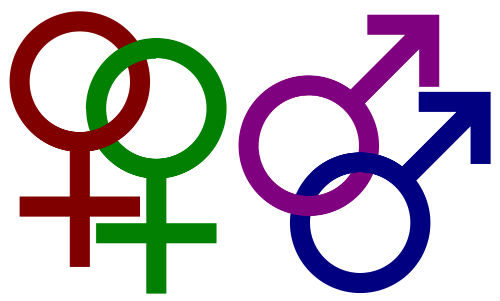One of the most controversial discoveries took birth during gender verification for the Olympic Games in 1992, where the athletes were categorized as female or male participants based on their genetic compositions.
However this method of grouping was eliminated in 2000. Today, many individuals belonging to the LGBTI category have been found to be working in high positions in many countries including India. Looking into the epics of India, like Mahabharata, the character named Shikhandi was said to be an extremely brilliant and clever one.
The research centre’s submission to the Royal Commission into Family violence said too many abuse victims in the lesbian, gay, bisexual, transgender and intersex (LGBTI) community suffer in isolation and many show a tendency to suicide…” was a news from a famous newspaper.
 “XX chromosomes give rise to a female offspring and XY chromosomes give rise to a male one” – a theory taught at school and believed worldwide. Then what are bisexuals, homosexuals and transgender? Is homosexuality a personal life style choice?
“XX chromosomes give rise to a female offspring and XY chromosomes give rise to a male one” – a theory taught at school and believed worldwide. Then what are bisexuals, homosexuals and transgender? Is homosexuality a personal life style choice?
Being a medico belonging to the Ayurvedic science, the category called Napumsaka was explained as a third gender and not a community to be avoided. Therefore, a study about sexuality had to be taken into consideration.
Sexuality may be defined as the gender to which an individual belongs. Just like any other physical or anatomical entity, one’s sexuality is also something which is confined to his/her biological constitution. Gender Expression refers to all the external characteristics and behavior that are socially defined as either masculine or feminine, such as dress, grooming, mannerism, speech patterns and social interactions. Gender Identity is a person’s private sense and subjective experience of his or her own gender.
This is generally described as a sense of being a man or woman, usually formed by the age of three years and is extremely difficult to change after that and at the same time Gender Orientation is the person’s behavior or choice of interest to a particular sex, which can be homosexual, heterosexual, bisexual, etc. Sexual differentiation starts with the development of male and female sexual organs from neural embryonic structures. Transgender denotes a person whose self identity does not conform unambiguously to conventional notions of male or female gender.
Process of Sex Determination in Earlier Times and Today
Previous concepts of factors determining gender identity:
- Child’s own personal interest
- Influence of others
- Social interactions
- Mass and media
In 1905, Y chromosome was identified as a sex determining chromosome by Nettie Stevens. He proposed that chromosomes always existed in pairs and that Y was the pair of X chromosome discovered in 1890 by Herman Henking. Later a protein called SRY (Sex determining Region Y/ Testis Determinig Region) protein located on Y chromosome (Yp 11.3) was discovered to be a DNA binding protein encoded by SRY gene. It was responsible for the initiation of male sex determination in humans. TDF is a member of SOX (SRY like box) gene family of DNA binding proteins.
 SF1 protein complexes with TDF acts as a transcription factor and up regulates other transcription factors, most importantly SOX9. Its expression causes development of primary sex cords, which later develop into Seminiferous tubules. These cords form in the central part of yet undifferentiated gonad, turning into testis. The now induced Leydig cells start secreting testosterone while Sertoli cells produce anti-Mullerian hormone. During gestation, the cells of the primordial gonad that lie along urogenital ridge are in bi potential state, i.e. they can differentiate into either male cells (Leydig cells and Sertoli cells) or female cells (follicle cells and thecal cells). In females, FOXL2 and Wnt4 inhibit the action of SOX9 and develop gonad into female fetus when in the presence of estrogen.
SF1 protein complexes with TDF acts as a transcription factor and up regulates other transcription factors, most importantly SOX9. Its expression causes development of primary sex cords, which later develop into Seminiferous tubules. These cords form in the central part of yet undifferentiated gonad, turning into testis. The now induced Leydig cells start secreting testosterone while Sertoli cells produce anti-Mullerian hormone. During gestation, the cells of the primordial gonad that lie along urogenital ridge are in bi potential state, i.e. they can differentiate into either male cells (Leydig cells and Sertoli cells) or female cells (follicle cells and thecal cells). In females, FOXL2 and Wnt4 inhibit the action of SOX9 and develop gonad into female fetus when in the presence of estrogen.
Disorders Related to SRY Gene and Y Chromosome
-
SWYER Syndrome
Crossing over during to paternal meiosis prior to conception can cause SRY to be transferred from the Y chromosome to the X chromosome. This Y chromosome that results from this crossing over is now lacking an SRY gene, and can no longer initiate testis development. When this chromosome is inherited from the father the resulting offspring will have Swyer syndrome, characterized by male karyotype (XY) and female phenotype.
-
XX Male Syndrome/46XX Testicular Disorder of Sex Development
The X chromosome that results from the crossover mentioned above now has an SRY gene, and therefore the ability to initiate testes development. The offspring who inherits this chromosome will have XX male syndrome, characterized by XX karyotype and male phenotype.
-
Androgen Insensitivity Syndrome
Individuals with AIS are unable to respond properly due to a defect in their androgen receptor gene, and affected individuals can have complete or partial AIS, characterized by male karyotype, but no masculinizing effects.
-
True Sterile Hermaphroditism
While most XX males develop phenotypically as males, some may experience incomplete differentiation of the testis, resulting in the formation of both testicular and ovarian tissues in the same individual. This is caused by the inactivation of the X chromosome containing the SRY in some cells.
-
Defective SRY or Mutation
If the SRY gene is defective or mutated, or if any of the contributory factors are defective, individuals who have the SRY gene, still develop as females. This can occur in individuals exhibiting an XY, XXY, or XX SRY-positive karyotype.
Role of Hormones in Brain Development
“Just as exposure to certain hormones play a role in fetal sex differentiation, such exposures also influence the sexual orientation and or gender identity that emerges later in the adult.” In humans the main preference responsible for sexual identity and orientation involves a direct effect of testosterone on the developing brain. Sexual organs are differentiated first and then the developing brain.
Sexual organs are differentiated first and then the brain is sexually differentiated under the influence of sex hormones mainly testosterone, estrogen and progesterone on the developing cells and under the presence of different genes as well. The changes brought about in this stage are permanent. This clearly means that an individuals’ sexuality is at 2 different stages, which may or may not complement each other.
Other Factors
Prenatal Maternal Stress causes maternal adrenal glands to release high levels of stress hormones into the blood stream, from which substantial amounts cross the placental barriers and reach the fetus, interfering its production of sex hormones (temporarily) mostly testosterone. This can affect the developing fetus’ sexual orientation.
Studies have shown that maternal stress along with smoking can result in homosexuality in the female offspring. Social factors were found not to affect sexuality, as previously thought. In an experimental study, a donor sperm was introduced in lesbian couples and the child born and brought up by them was heterosexual. “Therefore homosexuality is not a lifestyle choice
Ayurvedic Approach towards Sexuality
Ayurveda elaborates embryological aspects in the Sarira Sthana of Sushruta Samhita, where he says that an increased amount of sukra leads to a male child, more amount of sonita leads to a female offspring and equal amounts of both the Sukra (male reproductive factor/sperm) and Sonita (female reproductive factor/ovum) leads to a Napumsaka which cannot be exactly compared to a hermaphrodite, but one which has undergone defeminization but has not completed masculinization and vice versa. Here sukra not only denotes the sperm or seminal fluid, but also refers to the hormones (especially sex hormones) required for the normal functioning of the body like courage, aggressiveness, etc.
 Napumsaka are further classified into 5 types namely Asekya, Saugandhika, Kumbhika, Irsyaka and Shandhaka. Out of these Asekya, Saugandhika, Kumbhika and Irsyaka were described to possess sukra but exhibit sexual perversions instead of normalcy. The last one Sandha is of 2 types viz., Narsandha and Narisandha. If a man indulges in sexual intercourse with a woman like a female, the male progeny behaves like a female, called as Narasandha. If a woman undergoes coitus with a male like a man, the daughter is found to behave like a man called Narisandha. However both of them are said to lack sukra. Further studies are to be conducted for appropriate validation.
Napumsaka are further classified into 5 types namely Asekya, Saugandhika, Kumbhika, Irsyaka and Shandhaka. Out of these Asekya, Saugandhika, Kumbhika and Irsyaka were described to possess sukra but exhibit sexual perversions instead of normalcy. The last one Sandha is of 2 types viz., Narsandha and Narisandha. If a man indulges in sexual intercourse with a woman like a female, the male progeny behaves like a female, called as Narasandha. If a woman undergoes coitus with a male like a man, the daughter is found to behave like a man called Narisandha. However both of them are said to lack sukra. Further studies are to be conducted for appropriate validation.
Another reference enumerates 8 types of Napumsaka namely Dwiretha, Pavanendriya, Samskaravaahi, Narsandha, Narisandha, Vakri, Irshyaabhirati, Vataka sandhan. Among these, Dwiretha is seen to exibit both feminine and masculine characters, Pavanendriya does not possess sukra, Samskaravahi can produce sukra if subjected to Vajikarana prayoga, Vakri and Irshyabhirati show sexual perversions whereas Vataka sandha are found to have no testes or they get destroyed due to the vitiation of vata.
While discussing Garbhotpatakara bhavas, it clearly says that sukra comes from the father. Also the purpose of Vajikarana is aimed at not only producing successful offsprings but also healthy individuals of their coming generations.
In any of these classics or modern science it has not yet been mentioned that the individuals exhibiting altered sexuality are inferior to the normal population in terms of intelligence, IQ level, or other talents. They are neither found to show or possess any such character which may prove harmful to the society. In short, one’s sexuality is a predetermined one and not a lifestyle choice. Such an entity should not be considered as a means to corner them or title them as a social disgrace.
